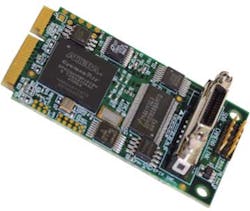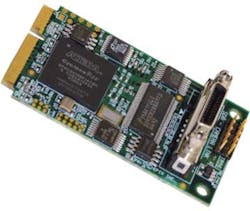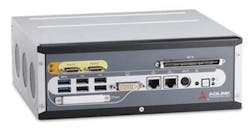Cameras may be the eyes of machine-vision and inspection systems, but interfaces and processors constitute the nervous systems and brains. Several products offer the capability to transport vision information or make decisions based on what cameras detect. The products have been introduced over the past few months or highlighted at The Vision Show in April in Boston.
For example, in March EPIX unveiled its PIXCI EB1mini 50.95-mm x 30.00-mm Camera Link frame grabber in a PCI Express Mini Card form factor (Figure 1). It captures images from a base-configuration line-scan or area-scan Camera Link camera, supports 250-Gb/s burst transfers of image data to a PCIe bus, and offers sustained image capture at rates of 200 MB/s. It provides trigger input, strobe output, shutter control, and 64-bit memory addressing and comes with XCAP-Lite software, which handles image-capture and camera control.
Figure 1. PIXCI EB1mini Camera Link Frame Grabber
Courtesy of EPIX
Pleora Technologies specializes in video interfaces. Founded in 2000 to deliver high-speed video over Ethernet, over the years the company has introduced Camera Link frame grabbers (in 2002), seen its embedded hardware integrated in a GigE camera (in 2003), cofounded the GigE Vision standardization committee (also in 2003), demonstrated GigE Vision over wireless (in 2012), and introduced a USB3 Vision video interface (in 2013), according to John Butler, manager of sales at the company, speaking at The Vision Show. He added that in 2006, the company’s PT1000-CL completed a NASA Space Shuttle mission.
The company’s most recent product is the iPORT CL-U3 external frame grabber, which transforms Camera Link cameras into USB3 Vision cameras. The iPORT CL-U3 converts images from Camera Link Medium or Base cameras into a USB3 Vision-compliant video stream. The uncompressed video is transmitted with low, consistent latency over a USB 3.0 cable directly to existing ports on a computer or display. By eliminating the need for a Camera Link frame grabber in a PCIe slot, designers can choose from a broad selection of small form factor and low-power computing platforms, including laptops, embedded systems, and tablets.
Butler cited several application areas for the new product. In industrial applications, he said, existing cameras can be converted into USB3 Vision cameras, allowing the use of thinner, lighter USB cables that are easier to route than Camera Link cables, enabling faster setup and teardown of work cells. It offers similar benefits in microscopy applications while eliminating the need for a PCIe frame grabber.
Another new product for the company is the iPORT CL-Ten frame grabber, which offers GigE Vision 2.0 connectivity for Camera Link full and medium over 10-GigE links. That product, he said, can be used in railway inspection systems, offering networking, multicasting, and long-distance reach advantages to allow processing equipment to be moved away from trackside. It also can serve in quality inspection systems, allowing the use of low-power, compact imaging platforms that can be located away from the harsh climate of an industrial inspection floor.
Processing boards
Micro/sys made its debut as an exhibitor at The Vision Show this year where it highlighted three camera/vision-ready industrial computer boards. The foray into the vision arena leverages the company’s 40 years of experience in the embedded single-board-computer market. President Susan Wooley said she expects vision will be a part of most embedded applications in the near future, and the company is ready to address vision applications.
On display at the company’s booth was the SBC4661, which incorporates Freescale’s i.MX6 Cortex-A9 Quad Core system-on-chip (SoC) multimedia processor. The low-power SBC4661 also includes a Xilinx Kintex-7 FPGA to enhance the board’s vision-processing capability. Users can configure the FPGA using cores from Xilinx’s library, third-party libraries, Micro/sys’s library, or their own proprietary algorithms.
Wooley said the board can serve security, transportation, industrial, and medical applications. I/O options include multiple USB3 channels, multiple serial channels, and dual CAN interfaces. Users have a choice of Linux and Android operating systems. The price starts at $1,295.
The company also exhibited its midrange, low-power SBC1652 with enhanced camera/video upgrades. The board incorporates Freescale’s i.MX515 CPU and a Spartan-6 FPGA, which offloads vision-processing algorithms, leaving the CPU free to service system routines and application programs. The board supports StackableUSB I/O expansion with USB 2.0, I2C, and SPI interfaces to help integrate data converters, GPS, mass storage, sensors, and other embedded I/O functions. The SBC1652 starts at $795. Turnkey development kits for Linux and WindowsCE are available for $995.
Micro/sys also exhibited the USB3200 industrial controller based on an 80-MHz PIC32 microcontroller. Wooley described it as offering “cellphone functionality” with 10-bit or 12-bit analog-to-digital conversion and up to 70 DIO lines as well as Ethernet, CAN, and USB interfaces. The board can handle single-shot photos or slow, low-resolution video in industrial-control environments.
Synchronized vision and I/O
National Instruments chose The Vision Show to highlight a variety of vision products. Carlton Heard, product marketing manager for embedded systems at the company, demonstrated a tightly synchronized vision and I/O application that provides a reliable, hardware-timed method of associating I/O with visually inspected parts. He also presented an FPGA-based system counting match heads at high frame rates. This demo illustrated how engineers can use NI LabVIEW to partition tasks between a system processor and FPGA to maximize frame rates.
After the show, NI released a tutorial in which Heard writes, “Cameras are becoming ubiquitous. There are cameras in cars, phones, laptops, TVs, traffic lights, and more. Just as vision is proliferating in the consumer space, the need for increased automation, higher quality manufacturing, and smarter machines has fueled the growth of vision being embedded into machines, robots, and other systems.”
Adding vision data to such systems, he says, enables them to gain a better understanding of their environment. “In many machines,” he continues, “the vision system is separated from the main machine controller, and results are passed via serial or Ethernet communications. However, many modern-day applications need lower latency, smaller size, or lower power than what a distributed system can provide.
“Combining the advanced control capabilities of CompactRIO with onboard image acquisition and processing provides tight synchronization between vision and I/O.”1 The tutorial explains how CompactRIO users can take advantage of USB3 Vision cameras, and it describes the design of a smart inspection capability for a semiconductor pick-and-place machine with tight I/O synchronization.
Smart camera complements processor line
Of course, processing need not be separated from the camera, and many firms offer smart cameras with built-in processing enabling them to make decisions on their own. For example, at The Vision Show, Heard demonstrated one of NI’s smart cameras inspecting candles.
As this article went to press, yet another company was planning to enter the smart-camera market. At The Vision Show, ADLINK provided a sneak preview of its new Neon-1040 smart camera. The company, with extensive offerings in the fields of test and measurement (with particular emphasis on PXI), applied computing, and automation, is poised to enter the camera business with its Neon-1040. The new smart camera features a 4-Mpixel global shutter sensor (CMOSIS CMV4000), an Intel Atom E3845 quad-core processor, and support for lighting control. (A version also will be available with a 2-Mpixel image sensor.)
The camera offers 16-GB storage for image processing and archiving, IP67 compliance for protection in harsh environments, and a web-based configuration utility. But, said ADLINK’s Jim Blasius, solutions architect, the real innovation comes with the Neon’s support of a slave camera to eliminate the need for a computing platform to provide additional interfaces, which reduces total solution cost. The new camera also offers GigE vision compliance to reduce application development time. In addition to the quad-core processor, the camera features an FPGA and GPU. The GenICam-compatible camera supports software including MVtec HALCON and Stemmer Imaging Common Vision Blox.
Figure 2. EOS-4000 Compact Camera Link Embedded-Vision System
Courtesy of ADLINK Technology
The camera complements ADLINK’s extensive line of vision products, including the EOS-4000 compact Camera Link embedded-vision system (Figure 2), which features a third-generation Intel Core i7/i5 quad core processor, two independent Power over Camera Link (PoCL) ports, and I/O capability. Camera Link connectivity provides image transmission with no CPU loading, combining with direct memory access to make the EOS-4000 suitable for speedy and accurate high-resolution performance supporting industrial-automation and medical-imaging environments.
References
Heard, C., “Giving Sight to CompactRIO,” National Instruments, Tutorial, May 5, 2014.


